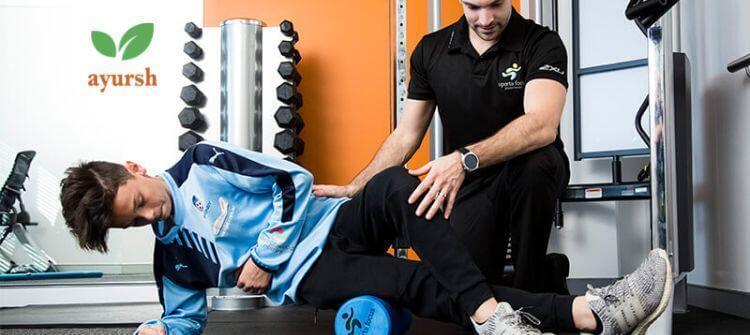Sports activities, whether professional or otherwise, can cause muscle strain or even serious injuries. If these problems are not given proper medical attention and treatment, they can worsen. However, these unwanted injuries can now be alleviated and prevented from happening again through the application of AYURSH SPORTS PHYSIOTHERAPY. You can maximize your performance and prevent future injuries through various techniques and exercises. Sports physiotherapy is meant to help you get back on track as soon as possible in a safe, secure, and effective way.
Ayursh Sports physiotherapy is geared towards both athletes and casual players who have suffered an injury or ongoing problem and is designed to help with injuries or conditions occurring during sports activities. The techniques include hands-on treatment ,rehabilitation and electric modalities. Whether you’re a professional athlete or at the beginning of your athletic journey, sports physiotherapy can be a suitable form of treatment for you.
HOW IT WORKS
Sports injuries are high-performance injuries that require utmost care. A Sports physiotherapist works closely with the athlete/ team to identify the requirements of a particular sport and bring out the best result post-injury in performance. For instance, if a midfield footballer injures his ankle while playing football and goes through rehab. He is given specialized rehab exercises to be able to run, cut directions and manipulate the ball like before the injury as per his sport. Depending on the sport a customized rehab program is designed to assist the athlete back to the sport. If it’s a cricket injury like hypertension in a fast bowler, then the bowler is guided to exercises that prevent hyperextension or stabilize the spine and assist in his return to cricket.
Sports physiotherapy can in fact provide various treatment modalities. The treatment approaches towards back pain and neck pain in regular patients will be dealt with various treatment techniques used in sports therapy and mainly on movement rehabilitation. For instance, Running has been taken up by many regular individuals for fitness, but they struggle with injuries due to a lack of guidance/knowledge.
WHAT ARE VARIOUS SPORTS WHICH REQUIRE PHYSIOTHERAPY
Players are at risk of injury at any moment, they can sustain injuries to the head, face, shoulder, arm, thigh, and knee There are various measures to prevent the injuries by making sure that the muscles and joints are properly warmed up, protective gears are used, using safety equipment, and doing proper cool-down exercises. The exercises should be done under the guidance of a trained and experienced physiotherapist. Sports in which injuries occur most commonly are:
-
Soccer/football
-
Tennis
-
Cricket
-
Hockey
-
Athletic
Though there are various other sports that also require physiotherapy treatment like Basketball, Volleyball, Rugby, Badminton, Cycling etc.
WHAT ARE THE COMMON CONDITIONS/SPORTS INJURIES THAT CAN BE TREATED BY SPORTS THERAPY
Muscle Strain: Muscle strain or pulled muscle is one of the most common sports injuries that often take place when a muscle is overstretched and gets torn. Muscle strains mainly affect the quadriceps, calves, quadriceps, groyne, lower back, and shoulder.
Tendonitis: Inflammation of the tendon is referred to as tendonitis, associated with overuse, but can also be developed when a traumatic injury creates micro-tears in the muscle fibers.
Stress Fracture: Stress fractures are also a form of overuse injury. It takes place when the muscles are no longer able to absorb the pressure, thus resulting in a fracture. Stress fractures usually affect the lower legs and feet and women athletes are more prone to such injury than men.
Contusions: Direct impact to the muscle causing injury is known as contusions. The faster the speed of the equipment that hits the player, the more severe the injury is resulting in swelling and bruising of the area. RICE is recommended for treatment, and medical assistance may be required for more severe contusions.
Whiplash Injury: Whiplash injury can happen by an abrupt or unexpected backward or forward motion of the neck. Falling suddenly or getting hit causes the head to jerk and the neck gets strained. It occurs commonly in contact sports, causing pain, numbness in the arms due to minor or major soft tissue damage to muscles and ligaments in the neck and vertebrae. The recovery of the player depends upon the severity of the injury.
Shoulder Impingement: Shoulder impingement occurs due to the repetitive overhead movement during playing. These repetitive concentric and eccentric movements place demands to maintain high levels of muscular control, required to maintain the stability of the shoulder joint. Initial physiotherapy treatment for these conditions is rest, ice, and Kinesio-taping. To increase the flexibility of the muscles, ligaments, and tendons, range of motion and strengthening exercises are designed by the physiotherapist.
Acromi-Oclavicular Joint Injury: The prevalence of shoulder injuries is high in hockey. The most commonly seen shoulder injury is Acromioclavicular (AC) joint injury, also known as a shoulder separation. This injury occurs due to direct contact hit into the shoulder. The severity can vary from a sprain to a complete tear of the involved ligaments. The physiotherapy treatment includes immobilization by rest in a sling followed by isometrics and gentle ROM exercises.
Rotator Cuff Injury: The most common cause of a rotator cuff tear is repetitive microtrauma, which can occur over some time. Bruising or swelling occurs due to the repeated rotator cuff injury by pinching or straining, catching, or squeezing the rotator cuff tendons. Physiotherapists focus on reducing inflammation and pain. The therapist recommends ROM exercises, isometric exercises, and capsular stretching, followed by isotonic exercises and aggressive pain-free strengthening.
Tennis Elbow: Tennis elbow injury occurs to the tendons located on the outer side of the elbow, this overuse and overload occur from the serve and forehand stroke. Physiotherapy treatment for tennis elbow involves rest, ice and Kinesio- taping. A wrist brace or tennis elbow band can be used and special physiotherapy exercises for stretching and strengthening the muscles are beneficial.
Golfer’s Elbow: Golfer’s elbow Or medial epicondylitis is caused due to excessive use of topspin and due to overload on the backhand stroke-causing pain and inflammation. Physiotherapy treatment involves rest, ice, and Kinesio- taping. A wrist brace can be used, followed by stretching and strengthening exercises.
Wrist Strain: Falling on an outstretched arm includes wrist sprains, wrist fractures, and shoulder dislocations. It can occur when the wrist moves in an abnormal position, suddenly twists, bends backward, or sustains heavy impact. The player feels tenderness, warmth, popping or tearing sounds, and difficulty in moving the wrist.
Carpal Tunnel Syndrome: These injuries occur due to the laid-back grip, rotation of the palm upward, and quickly turning the wrist to perform the topspin. Treatment for these conditions involves rest, ice and range of motion, and strengthening exercises.
Lower Back Pain
Players suffer from low back pain due to the fast weight transfers, jumping, and twisting, resulting in repeated flexion, extension, rotation and lateral flexion of the spine commonly required during cocking or loading phase of the tennis serve. The physiotherapist designs strengthening exercises for back and abdominal muscles to increase strength.
Femoroacetabular Impingement: Femoroacetabular impingement can occur due to the multidirectional movement pattern, loading and abruptly starting, cutting, twisting, and stopping. This form of hip injury can be treated with the help of RICE and physiotherapy sessions under the guidance of a physiotherapist.
Groyne Pull: Groyne pull occurs as a result of a pull or stretch of the muscles of the inner thigh. The player feels pain and tenderness in the groyne and the inside of the thigh while raising the knee or while bringing the legs together. The player feels severe pain with a popping or snapping sound during the injury.
Iliotibial Band Syndrome: Iliotibial band syndrome occurs due to the overuse injury along the outer thigh. Due to continuous friction created by the IT band along the outer side of the thigh, during running. The player feels pain and tenderness on the lateral or outer part of the thigh and knee just above the knee joint.
Hamstring Strains: A hamstring strain is usually caused when the muscles become overloaded, leading to a strain, or a complete tear. Hamstrings are usually injured during sprinting i.e during fast bowling while fielding or running between wickets as a batsman. The player feels a sudden or severe pain during exercise, pain or tightness while straightening or bending the leg, and weight-bearing. Physiotherapy treatment starts with RICE followed by progressive strengthening through exercise, soft tissue massage, scar tissue mobilization, dry needling, and taping.
Torn ACL: ACL or anterior cruciate ligament helps in keeping the knee joints together and brings stability. A Torn ACL is extremely painful and restricts the ability to walk. The injury takes place from a direct shot to the knees, or from incorrect landing and or stopping and changing direction quickly.
Torn MCL: It is another form of a knee injury, which takes place when the medial collateral ligament that connects the femur to the tibia is injured. It is caused when the knees are pushed sideways. This form of knee injury can be treated with help of ice compression, braces, and sports physical therapy sessions under the watchful eyes of a sports physiotherapist.
Patellofemoral Pain Syndrome: Patellofemoral pain syndrome or runner's knee is a condition in which the cartilage under the kneecap is damaged due to injury. It can occur due to strained tendons or misalignment in the knee. The player feels pain while exercising, bending the knee, climbing the stairs, squatting, and jumping. The player feels cracking or popping sounds in the knee while climbing stairs or after sitting for a longer duration with the knee bent.
Shin Splints: It affects the insides of the lower leg or shin area and is an overuse injury and also a common injury found among runners. Athletes having flat feet are more susceptible to this form of injury.
Plantar Fasciitis: Plantar Fasciitis is the inflammation of the plantar fascia ligament that connects the heel to the front of the foot. Putting too much strain and stress are the major reasons behind this form of injury and is usually treated with rest, ice, and stretching exercises.
Ankle Sprains: Medial ankle sprain can occur when the toes are turned out while the foot is flexed upward. Lateral ankle sprains can occur in soccer when a player kicks the ball with the top of their foot. Ankle sprains take place when the ligament that supports the joint gets overstretched due to incorrect stepping or stepping on an uneven surface or due to twists and rolls. Usually, ankle strains heal with RICE – rest, ice, compression, and elevation.
Achilles Tendon Rupture: Achilles tendon rupture occurs due to the partial or complete tear of the Achilles tendon. This can occur when a player performs a fast or jerky movement. Ankle sprains occur when the ligaments (surrounding the ankle joint) are stretched or torn.
Rehabilitation after a sports injury is a crucial aspect to ensure full recovery, minimize time off from sports, and to prevent reinjury. Modern rehabilitation methods have surpassed traditional management protocols and are based on an active rehabilitation framework that demands equal participation from the athlete and the entire rehabilitation team.



